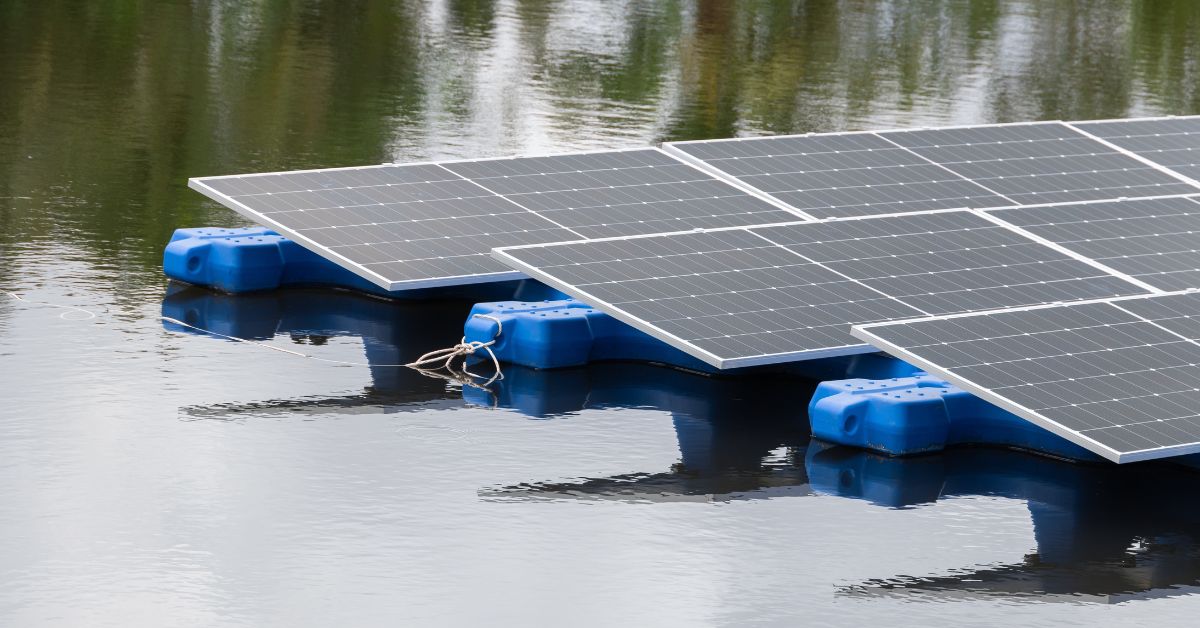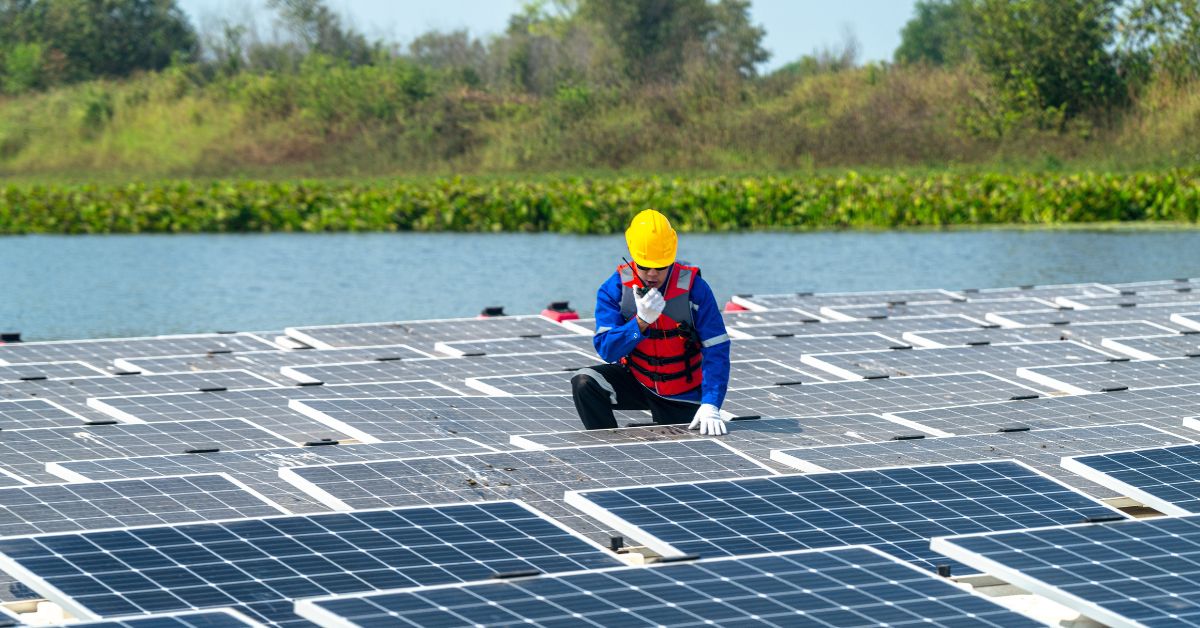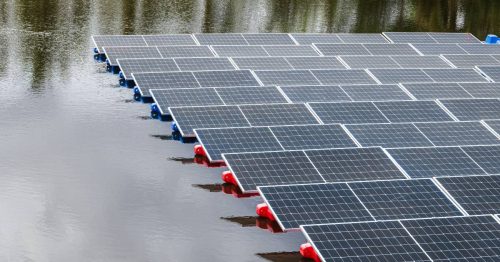Featured image courtesy: Shutterstock (For representational purposes only)
It’s early morning at the Ramagundam reservoir in Telangana’s Peddapalli district. The water is still, broken only by the occasional ripple of a passing bird. From the shore, you see something unusual — thousands of gleaming blue panels stretching far into the distance, quietly soaking up the sun.
This isn’t a mirage. It’s one of India’s largest floating photovoltaic (FPV) plants, generating 100 megawatts (MW) of clean electricity without claiming an inch of farmland.
For a country like India, where every square metre of land is contested between farms, factories, and cities, this technology feels almost transformative.
So, how does it work?
The simple idea behind floating solar
The concept is elegantly simple: instead of fixing solar panels to the ground, you mount them on buoyant platforms and let them float on water bodies — reservoirs, lakes, industrial ponds, and irrigation canals.
This approach delivers immediate benefits:
- No land-use conflict: It frees up land for agriculture, housing, or conservation.
- Higher efficiency: The cooling effect of water prevents overheating, boosting output by up to 10 percent compared to ground-mounted systems. This is because lower panel temperatures reduce electrical resistance, allowing more sunlight to be converted into electricity.
In water-stressed regions, FPV brings another bonus: panels shade the surface, slowing evaporation. Studies show a one-megawatt FPV plant can prevent more than 1,300 cubic metres of water loss each year. At Ramagundam, the National Thermal Power Corporation (NTPC) plant is expected to save two billion litres annually, enough to meet the water needs of 10,000 households. Experts say this benefit is just one example of the versatility of floating solar.
As renewable energy expert Harsh Tiwari, founder of EMPBindi International, explains: “In places like Rajasthan, rainwater harvesting ponds are common, but evaporation is a huge problem. If we cover these ponds with floating solar panels, we not only reduce evaporation but also generate electricity. This can be connected to a village microgrid, providing backup power for homes or for irrigation.” (A village microgrid is a small-scale electricity network that can operate independently from the main grid, ensuring power even during outages.)

And FPV pairs beautifully with another clean power source. Sanjeev Jain, retired chief engineer (energy department) from the Government of Chhattisgarh, says, “FPV and hydropower are natural allies. During the day, solar can supply power, while hydropower can be used in the evenings, creating a balanced generation profile.” In other words, the two work in tandem — water-driven turbines take over when the sun sets, ensuring a steady power supply.
He adds, “Installing FPV on reservoirs of existing hydropower plants also eliminates the need for new transmission infrastructure. It’s a win-win situation.”
And that potential is already being tapped in different corners of the country.
From mines to megawatts: India’s push to scale floating solar
India’s state-run power giant, the NTPC, has commissioned floating solar projects in Telangana, Kerala, and several more states.
In Chhattisgarh, Sanjeev has been closely involved. “Chhattisgarh is blessed with numerous water bodies, which makes it ideal for FPV systems,” he says. “The state’s first major project, a 15 MW floating solar plant, is being set up by Steel Authority of India Limited (SAIL)–Bhilai at the Maroda-1 reservoir, in partnership with NTPC. It will generate about 34.26 million units annually for captive use at the Bhilai Steel Plant, helping reduce its carbon footprint.” (In practice, this means the plant directly uses the generated solar power, reducing its need to draw electricity from coal-heavy state grids.)
Sanjeev adds, “Apart from Maroda-1, NTPC has projects planned in Korba and other locations. We have mapped around 3,000 MW of FPV potential across the state’s water bodies, including a single site, Sikassa Dam, with a staggering 2,500 MW potential.”
However, not all FPV sites are traditional reservoirs.
In Rajasthan, Oriana Power commissioned a 1 MWp floating solar plant for Udaipur Cement Works Limited, not on a river or lake, but on the Dabok mine pond — a deep water-filled crater left by years of limestone extraction.

The results speak for themselves: 1.7 million units of clean electricity generated annually, 4.4 million litres of water saved, and evaporation reduced by up to 70 percent. That amount of power could meet the annual needs of over a thousand average Indian homes, while the water saved is nearly equivalent to two Olympic-size swimming pools.
Rajasthan’s mining belts in Udaipur, Chittorgarh, and Nagaur are dotted with hundreds of such pits, now filled with rainwater or groundwater seepage.
Harsh sees untapped opportunity here: “In marble and stone mining areas, water used for cutting is collected in large ponds that don’t seep much because of the stone bed. These ponds could host FPV to power nearby industrial zones or feed backup power to the grid. It’s a productive reuse of land and water, plus renewable generation.”
And beyond powering industries, the impact of floating solar reaches well past the energy sector.
The promise beyond power
More than an engineering win, floating solar is an environmental ally, whose benefits go beyond power generation.
- Water conservation: Panels block sunlight, cutting evaporation losses by up to 90 percent and suppressing algae growth.
- Carbon savings: FPV on hydropower reservoirs could cut 3.3 million tonnes of carbon dioxide annually.
- Ease of deployment: No major earthworks are needed, avoiding the cost and disruption of site preparation.
With such advantages, the question is how widely this technology can be deployed — and the answer could be game-changing.
Gigawatts waiting to be tapped
Across India — from Kerala’s backwaters to Rajasthan’s mine ponds — FPV is gathering momentum. Experts say the theoretical potential exceeds 200 gigawatts (GW) if just a fraction of reservoirs hosted floating solar.

In water-scarce states like Rajasthan and Maharashtra, FPV could prove transformational. Harsh notes: “It conserves water, generates clean energy, and can be deployed without competing for farmland. We just need stronger policy support, pilot projects on government-owned reservoirs, and technology adapted for local needs. India can also look abroad for lessons. Countries like China, Japan, and even island nations like the Maldives have embraced FPV thanks to geography and policy support.”
But turning that potential into reality will mean addressing some tough hurdles along the way.
The challenges under the surface
The path to FPV adoption isn’t entirely smooth.
- Higher upfront costs: FPV costs seven to 10 percent more than ground-mounted solar, largely due to floating platforms, which make up about 35 percent of project costs.
- Data gaps: Many water bodies remain unmapped for solar potential, hampering design and impact assessment.
- Social impacts: Some mega-projects have disrupted fishing livelihoods. For generations, fishermen depended on these waters, but are now barred from accessing them. They say officials surveyed affected families yet offered no support, and that promised jobs in the project have not materialised — not even basic labour work.
- No tailored standards: Current solar module standards are for land-based systems; floating arrays face unique challenges like humidity and corrosion.
- Skills shortage: FPV requires marine engineering, hydraulics, and float manufacturing expertise, all still scarce in India.

Harsh sees permissions, awareness, and design innovation as the biggest bottlenecks: “While the World Bank has identified FPV as viable, the Indian government hasn’t pushed it strongly yet. Adapting the technology for water conditions and ensuring safety adds cost. We’re trying to develop a concept note for CSR and philanthropic partners to fund pilots in drought-prone regions.”
Meanwhile, Sanjeev emphasises policy reform. “Interdepartmental coordination, at both state and central levels, is critical. We need a clear policy for water body usage, like we have for land-based solar. Viability Gap Funding could offset the higher costs, as with battery storage systems.” Such funding allows part of a project’s expense to be covered, making it easier for developers to take on ambitious installations while policies ensure smoother clearances.
A ripple becoming a wave
India has begun turning potential into practice. What once sounded abstract now feels like tangible ambition: the panels floating on reservoirs are ready to help bridge the country’s power needs and water worries, while aligning with its renewable future.
If innovation continues, policy gaps close, and communities stay at the heart of design and planning, floating solar can grow into a solution people can see and feel in their everyday lives — turning still waters into spaces that light up homes, power livelihoods, and protect the resources we all depend on.
No comments:
Post a Comment